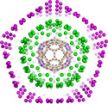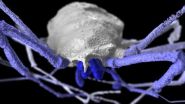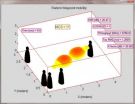(Press-News.org) Newborns whose mothers were exposed during pregnancy to any one of a variety of environmental stressors — such as trauma, illness, and alcohol or drug abuse — become susceptible to various psychiatric disorders that frequently arise later in life. However, it has been unclear how these stressors affect the cells of the developing brain prenatally and give rise to conditions such as schizophrenia, post-traumatic stress disorder, and some forms of autism and bipolar disorders.
Now, Yale University researchers have identified a single molecular mechanism in the developing brain that sheds light on how cells may go awry when exposed to a variety of different environmental insults. The findings, to be published in the May 7 issue of the journal Neuron, suggest that different types of stressors prenatally activate a single molecular trigger in brain cells that may make exposed individuals susceptible to late-onset neuropsychiatric disorders.
The researchers found that mouse embryos exposed to alcohol, methyl-mercury, or maternal seizures all activate in the developing brain cells a single gene — HSF1 or heat shock factor — which protects and enables some of the brain cells to survive prenatal insult. Mice lacking the HSF1 gene showed structural brain abnormalities and were prone to seizures after birth, even after exposure to very low levels of the toxins.
In addition, researchers created stem cells — which are capable of becoming many different tissue types, including neurons — from biopsies of individuals diagnosed with schizophrenia. Genes from these "schizophrenic" stem cells responded more dramatically when exposed to environmental insults than stem cells obtained from non-schizophrenic individuals. The findings provide support to the thesis that stress induces vulnerable cells to malfunction.
"It appears that different types of environmental stressors can trigger the same condition if they occur at the same period of prenatal development," said Yale's Pasko Rakic, senior author of the study. "Conversely, the same environmental stressor may cause different pathologies, if it occurs at different times during pregnancy."
Since HSF1 activation can potentially serve as a permanent marker of the stressed/damaged cell, it opens the possibility of identifying these cells in adults in order to explore the pathogenesis of postnatal disorders and how to protect vulnerable cells.
INFORMATION:
Rakic is the Dorys McConnell Duberg Professor of Neuroscience and Professor of Neurology and Director of the Yale Kavli Institute for Neuroscience and corresponding author. Kazue Hashimoto-Torii formerly of Yale and now at the Center for Neuroscience, Children's National Medical Center, Washington, DC is lead author of the paper.
The research was funded primarily though grants R01 NS014841, R01 DA023999 and K99/R00-AA018387 from the National Institutes of Health.
Yale researchers search for earliest roots of psychiatric disorders
2014-04-10
ELSE PRESS RELEASES FROM THIS DATE:
Some birds come first -- a new approach to species conservation
2014-04-10
New Haven, Conn.— A Yale-led research team has developed a new approach to species conservation that prioritizes genetic and geographic rarity and applied it to all 9,993 known bird species.
"To date, conservation has emphasized the number of species, treating all species as equal," said Walter Jetz, the Yale evolutionary biologist who is lead author of a paper published April 10 in Current Biology. "But not all species are equal in their genetic or geographic rarity. We provide a framework for how such species information could be used for prioritizing conservation."
Worldwide, ...
Penn study finds mechanism that regulates lung function in disease Birt-Hogg-Dube syndrome
2014-04-10
(PHILADELPHIA) – Researchers at Penn Medicine have discovered that the tumor suppressor gene folliculin (FLCN) is essential to normal lung function in patients with the rare disease Birt-Hogg-Dube (BHD) syndrome, a genetic disorder that affects the lungs, skin and kidneys. Folliculin's absence or mutated state has a cascading effect that leads to deteriorated lung integrity and an impairment of lung function, as reported in their findings in the current issue of Cell Reports.
"We discovered that without normal FLCN the alveolar epithelial cells (AEC) in these patients' ...
Ancient 'spider' images reveal eye-opening secrets
2014-04-10
VIDEO:
This is a video showing the 305-million-year-old harvestman fossil.
Click here for more information.
Stunning images of a 305-million-year-old harvestman fossil reveal ancestors of the modern-day arachnids had two sets of eyes rather than one.
The researchers say their findings, published in the journal Current Biology, add significant detail to the evolutionary story of this diverse and highly successful group of arthropods, which are found on every continent except Antarctica.
University ...
Poor mimics can succeed as long as they mimic the right trait
2014-04-10
There are both perfect and imperfect mimics in nature. An imperfect mimic might have a different body shape, size or colour pattern arrangement compared to the species it mimics.
Researchers have long been puzzled by the way poor mimicry can still be effective in fooling predators not to attack. In the journal Current Biology, researchers from Stockholm University now present a novel solution to the question of imperfect mimicry.
Mimicry is when animals have the appearance of another species in order to avoid being attacked. For instance, hoverflies have a similar ...
Enzyme 'wrench' could be key to stronger, more effective antibiotics
2014-04-10
Builders and factory workers know that getting a job done right requires precision and specialized tools. The same is true when you're building antibiotic compounds at the molecular level. New findings from North Carolina State University may turn an enzyme that acts as a specialized "wrench" in antibiotic assembly into a set of wrenches that will allow for greater customization. By modifying this enzyme, scientists hope to be able to design and synthesize stronger, more adaptable antibiotics from less expensive, natural compounds.
Kirromycin is a commonly known antibiotic ...
NEJM: High-risk seniors surgery decisions should be patient-centered, & physician led
2014-04-10
Surgery for frail, senior citizen patients can be risky. A new patient-centered, team-based approach to deciding whether these high-risk patients will benefit from surgery is championed in an April 10 Perspective of the New England Journal of Medicine. The Perspective suggests that the decision to have surgery must balance the advantages and disadvantages of surgical and non-surgical treatment as well as the patient's values and goals in a team-based setting that includes the patient, his or her family, the surgeon, the primary care physician and the physician anesthesiologist.
One ...
Virus structure inspires novel understanding of onion-like carbon nanoparticles
2014-04-10
Symmetry is ubiquitous in the natural world. It occurs in gemstones and snowflakes and even in biology, an area typically associated with complexity and diversity. There are striking examples: the shapes of virus particles, such as those causing the common cold, are highly symmetrical and look like tiny footballs.
A research programme led by Reidun Twarock at the University of York, UK has developed new mathematical tools to better understand the implications of this high degree of symmetry in these systems. The group pioneered a mathematical theory that reveals unprecedented ...
New towns going up in developing nations pose major risk to the poor
2014-04-10
DENVER (April 10, 2014) – Satellite city projects across the developing world are putting an increasing number of poor people at risk to natural hazards and climate change, according to a new study from the University of Colorado Denver.
Throughout Asia, Africa and Latin America `new towns' are rapidly being built on the outskirts of major cities with the goal of relieving population pressures, according to study author Andrew Rumbach, PhD, assistant professor of planning and design at CU Denver's College of Architecture and Planning.
The towns often sit in high flood ...
Four-eyed daddy longlegs fossil fills in evolutionary tree
2014-04-10
Living harvestmen—a group of arachnids more commonly known as daddy longlegs—have a single pair of eyes that help them navigate habitats in every continent except Antarctica. But a newly described 305-million-year-old fossil found in eastern France shows that wasn't always the case. New research recently published in the journal Current Biology and led by scientists at the American Museum of Natural History and the University of Manchester indicates that primitive harvestmen had two pairs of eyes, adding significant details to the evolutionary story of this diverse and ...
New research on gigabit wireless communications
2014-04-10
Research on gigabit wireless communications has been presented by researchers from the University of Bristol at the world's leading wireless communications and networking conference, IEEE WCNC 2014, in Turkey earlier this week [Monday 6 to Wednesday 9 April].
The two research papers, led by Andrew Nix, Professor of Wireless Communication Systems and Dr Simon Armour, Senior Lecturer in Software Radio, from the University's Communication Systems and Networks research group in the Department of Electrical and Electronic Engineering, could have significant implications for ...



